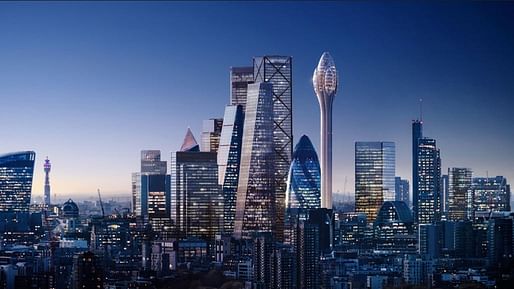
The UK government has rejected the Foster + Partners-designed Tulip Tower, bringing an end to years of uncertainty over the project’s future. The scheme’s rejection by Housing Secretary Michael Gove and housing minister Christopher Pincher comes only one month after speculation within the British press that Gove was expected to approve the scheme.
The £500 million ($691 million) project was unveiled by Foster + Partners in 2018, rising 305 meter to become the tallest building in London’s financial district. The 12-story viewing pod at the building’s summit was described as a “classroom in the sky” which could accommodate 20,000 schoolchildren every year as well as bars and restaurants.

Today's rejection of the scheme by the UK government follows the advice of planning inspector David Nicholson who, as the UK’s Architect’s Journal reports, advised the scheme be rejected following a multi-week public inquiry held in November 2020.
Nicholson’s report, which is now public, expresses concern over the Tulip’s “poor lifetime sustainability.” While praising the project’s adaption of sustainability techniques to reduce emissions during construction and building use, the report concludes that “fulfilling the brief with a tall, reinforced concrete lift shaft, would result in a scheme with very high embodied energy and an unsustainable whole life-cycle.”

Beyond climate, Nicholson’s report expresses concerns over the Tulip’s impact on London’s architectural heritage, noting that the form, materials, location, and proposed use for the scheme would “cause considerable harm to the significance of the Tower of London and further harm to other designated heritage assets.”
The report also questions the scheme’s adaptability for future use, noting that “little if any thought has been given to how the building would function over its extended lifetime,” particularly if a viewing platform on the site was no longer desired at a future date.

The tower was originally submitted for planning by Foster + Partners in 2018 to the relevant local authority, the City of London Corporation. Although the City of London approved the scheme in 2019, that decision was overruled by London Mayor Sadiq Khan, who argued that the tower’s lack of office and housing provision was out-of-step with London’s needs. In their 2019 rejection, Kahn’s office said the scheme was “of insufficient quality for such a prominent location” and would “result in harm to London’s skyline.”
The decision overt the tower’s future was subsequently placed in the hands of then-Housing Secretary Robert Jenrick. However, Jenrick was removed from the post in September 2021 following his approving of a controversial $1.3 billion residential development connected to a political ally. Responsibility for the Tulip’s future therefore passed to his successor, Michael Gove, whose rejection of the scheme today spells the end of the line for the Tulip Tower.
7 Comments
Yay! This thing was very unbecoming for London. Maybe Foster can recycle the design in a second tier city on some other continent.
Im sure Dubai is buying rights to this stupidity
big win- hope to see more of this from cities everywhere.
Doh!
At COP26, Norman Foster speaks about the primacy of cities in the fight against climate change
Norman Foster digs in on his stance on airport emissions
Norm's in a hopelessly contradictory place these days.
"classroom in the sky..... bars and restaurants"
ego is a funny thing
Block this user
Are you sure you want to block this user and hide all related comments throughout the site?
Archinect
This is your first comment on Archinect. Your comment will be visible once approved.